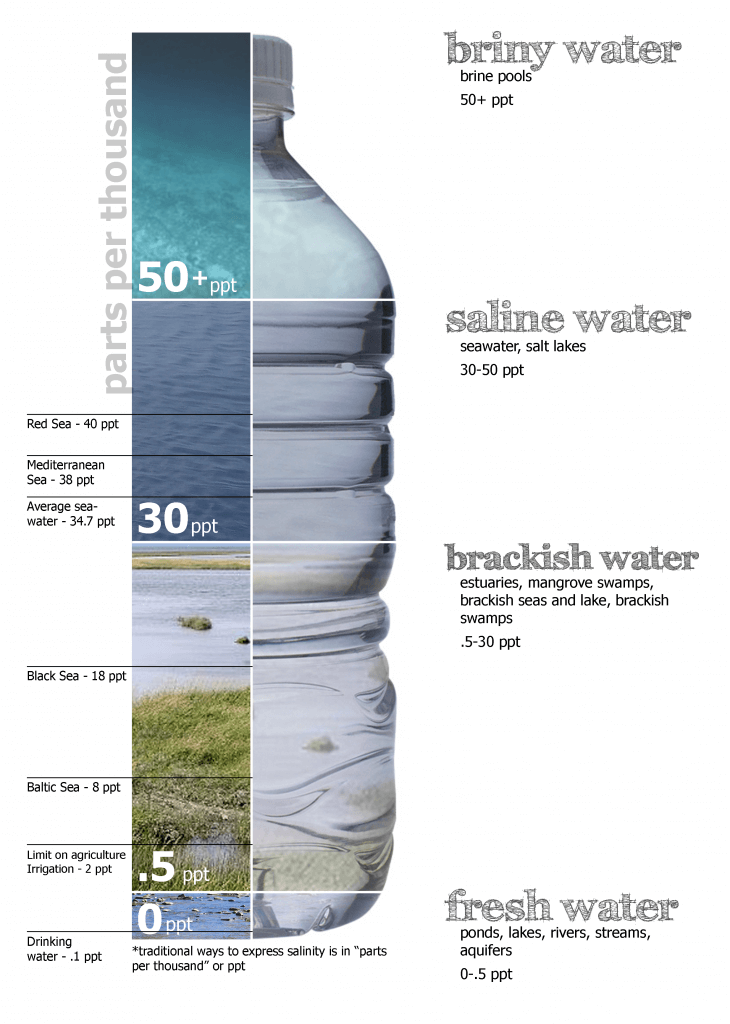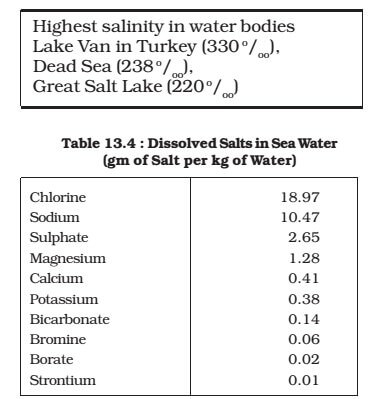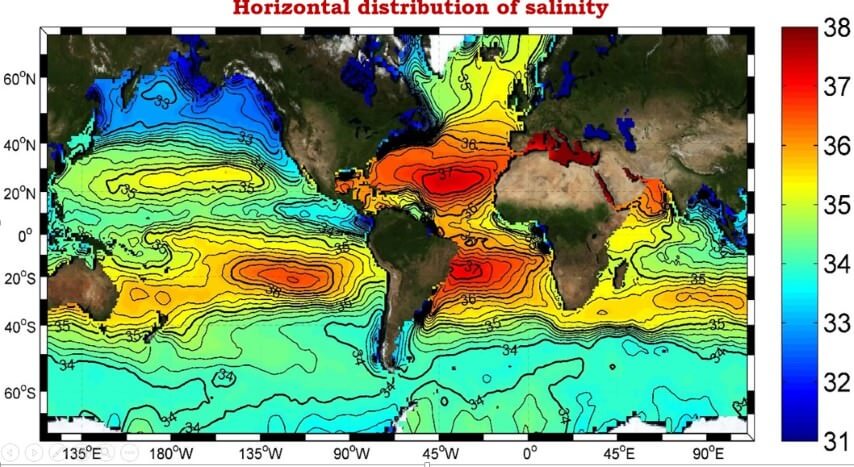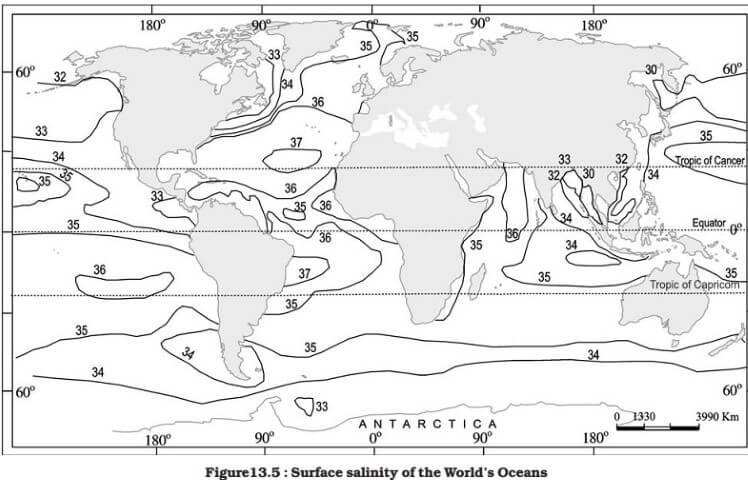This article talks about the Salinity of ocean waters – for UPSC.
Salinity of Ocean Water
- Salinity means the total content of dissolved salts in Sea or Ocean.
- Salinity is calculated as the amount of salt dissolved in 1,000 gm of seawater.
- It is generally expressed as ‘parts per thousand’ (ppt).
- A salinity of 24.7 % has been regarded as the upper limit to fix ‘brackish water’.
- It is a significant factor in deciding several characteristics of the chemistry of natural waters and biological processes.
- Isohalines are used on maps to show the salinity of different places.
- Isohalines – lines joining places having an equal degree of salinity.
- The average salinity of the ocean – 3.5% or 35 parts of salt in 1000 parts of water.

The salinity of the Great Salt Lake, (Utah, USA), the Dead Sea, and the Lake Van in Turkey are 220, 240, and 330 respectively.
Role of Ocean Salinity
- Salinity determines compressibility, thermal expansion, temperature, density, absorption of insolation, evaporation, and humidity.
- It also influences the composition and movement of the sea: water and the distribution of fish and other marine resources.
Share of different salts is as shown below—
- sodium chloride — 77.7%
- magnesium chloride—10.9%
- magnesium sulphate —.4.7%
- calcium sulphate — 3.6%
- potassium sulphate — 2.5%

Factors Affecting Salinity of Ocean Water
- There are sections of the ocean where there is little rain yet there is a lot of evaporation due to the warm, dry breezes.
- This evaporation removes water; but, because water vapor leaves salt behind when it rises into the atmosphere, the saltiness of the saltwater grows.
- The ocean becomes denser as a result of this.
- High salinity can be found in the north and south Atlantic, which are locations with strong winds and little rain.
Rate of evaporation
- The ocean between 20°N and 30°N latitudes has more salinity than the temperate latitude ocean due to a higher rate of evaporation (because of high temperature).
- However, due to the considerations indicated in the next paragraph, this does not entail that tropical oceans will have more salinity.
Amount of Freshwater Added
- The places having high daily rainfall, high relative humidity, and addition by freshwater have low salinity.
- E.g. Oceans into which huge rivers like Amazon, Congo, Ganges, Irrawaddy, and Mekong drain have lower salinity.
- The Baltic, Arctic, and Antarctic waters have a salinity of <32 ppt because much freshwater is added from the melting of icebergs, as well as by several large poleward bound rivers.
The degree of water mixing by currents
- As there is no mixing of freshwater and continual evaporation in land-locked (enclosed by lands) areas, the salinity is higher.
- For example, the Black Sea, the Caspian Sea, the Red Sea, and the Persian Gulf.
- Where there is free mixing of water by surface and subsurface currents, the salinity range is small.
| Sea | Salinity (in ppt) |
| Baltic Sea | 7 |
| Red sea | 39 |
| Caspian Sea | 180 |
| Dead Sea | 250 |
| Lake Van | 330 |
Horizontal distribution of salinity
To make life easier, I will remove the symbol o/oo and place only the number.
- The salinity for normal open ocean ranges between 33 and 37.
High salinity regions
- In the landlocked Red Sea (don’t confuse this to the Dead Sea which has much greater salinity), it is as high as 41.
- In hot and dry regions, where evaporation is high, the salinity sometimes reaches 70.
Comparatively Low salinity regions
- In the estuaries (enclosed mouth of a river where fresh and saline water get mixed) and the Arctic, the salinity fluctuates from 0 – 35, seasonally (freshwater coming from ice caps).
Pacific
- The salinity variation in the Pacific Ocean is mainly due to its shape and larger areal extent.
Atlantic
- The average salinity of the Atlantic Ocean is around 36-37.
- The equatorial region of the Atlantic Ocean has a salinity of about 35.
- Near the equator, there is heavy rainfall, high relative humidity, cloudiness, and calm air of the doldrums.
- The polar areas experience very little evaporation and receive large amounts of freshwater from the melting of ice. This leads to low levels of salinity, ranging between 20 and 32.
- Maximum salinity (37) is observed between 20° N and 30° N and 20° W – 60° W. It gradually decreases towards the north.

Indian Ocean
- The average salinity of the Indian Ocean is 35.
- The low salinity trend is observed in the Bay of Bengal due to the influx of river water by the river Ganga.
- On the contrary, the Arabian Sea shows higher salinity due to high evaporation and a low influx of fresh water.
Marginal seas
- The North Sea, in spite of its location in higher latitudes, records higher salinity due to more saline water brought by the North Atlantic Drift.
- Baltic Sea records low salinity due to the influx of river waters in large quantities.
- The Mediterranean Sea records higher salinity due to high evaporation.
- Salinity is, however, very low in the Black Sea due to the enormous freshwater influx by rivers.
Inland seas and lakes
- The salinity of the inland Seas and lakes is very high because of the regular supply of salt by ‘ the rivers falling into them.
- Their water becomes progressively more saline due to evaporation.
- For instance, the salinity of the Great Salt Lake, (Utah, USA), the Dead Sea, and the Lake Van in Turkey are 220, 240, and 330 respectively.
- The oceans and salt lakes are becoming saltier as time goes on because the rivers dump more salt into them, while freshwater is lost due to evaporation.
Cold and warm water mixing zones
- Salinity decreases from 35 – 31 in the western parts of the northern hemisphere because of the influx of melted water from the Arctic region.

Sub-Surface Salinity
- With depth, the salinity also varies, but this variation again is subject to latitudinal difference. The decrease is also influenced by cold and warm currents.
- In high latitudes, salinity increases with depth. In the middle latitudes, it increases up to 35 metres and then it decreases. At the equator, surface salinity is lower.
Vertical Distribution of Salinity
- Salinity changes with depth, but the way it changes depends upon the location of the sea.
- Salinity at the surface increases by the loss of water to ice or evaporation or decreased by the input of freshwaters, such as from the rivers.
- Salinity at depth is very much fixed because there is no way that water is ‘lost’, or the salt is ‘added.’ There is a marked difference in the salinity between the surface zones and the deep zones of the oceans.
- The lower salinity water rests above the higher salinity dense water.
- Salinity, generally, increases with depth and there is a distinct zone called the halocline (compare this with thermocline), where salinity increases sharply.
- Other factors being constant, increasing the salinity of seawater causes its density to increase. High salinity seawater, generally, sinks below the lower salinity water. This leads to stratification by salinity.
Salt Budget
It is also known as the salt cycle. It involves all the processes through which salt moves from the ocean into the lithosphere, to a certain extent into the atmosphere, and back into the oceans.
- Moving water, including groundwater, leaches minerals from the rocks through the process of surface erosion. The mineral-laced water joins the rivers and streams which finally reach the oceans. These minerals add to the salinity levels of the ocean waters.
- Some of the salts in the ocean waters accumulate at the ocean bottom through the process of sedimentation turning into mineralized rocks. Over a period of millions of years, some of these rocks get raised above the ocean surface due to plate tectonics, or due to volcanic activity. This brings the salt back to the lithosphere in the form of minerals (rocks).
- Salt from the oceans also gets sprayed into the atmosphere due to the action of wind. This salt returns to the lithosphere mixed with precipitation. However, this constitutes a tiny fraction of salt moving from the land to the sea and vice versa.
- Salt cycle operates over a very long period of time.
Every year, around 3 billion tons of salt get added to the oceans from the land. A tiny fraction of this salt is extracted by humans for daily consumption.

Its useful for writing msc environmental science notes
You are provided the good contentS….Thanking you so much for your selfless service .
where’s the temp note?
your content is the most valuable for me. Thanks for sharing with us.
Most Welcome Pankaj
Thanks a lot for sharing content.
Isko whatsapp pr send kase Krna h
Copy the URL, and paste on Whatsapp.
use mains or not only for PRILMS 🤔